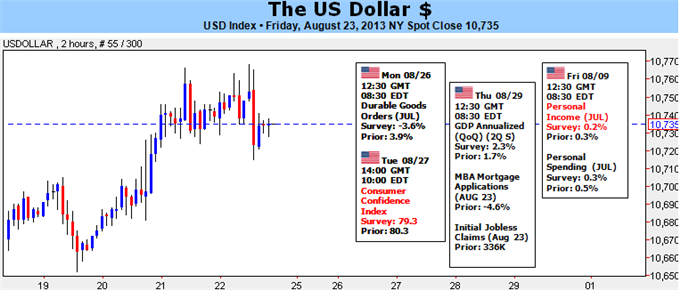
Dollar Rebound at Risk if Taper Doesn’t Inspire Risk Aversion
Fundamental Forecast for US Dollar: Neutral
NY Fed survey shows primary dealers expect $15 bln September Taper, further $15 bln cut in December
EURUSD and USDJPY face significant dollar pivot points – with contrasting expectations
Use the DailyFX-Plus Technical Analyzer to identify possible trade setups
Though we have yet to see the wave of deleveraging wash over US equities – the stronghold of moral hazard – we have nonetheless seen a significant market adjustment to the September Fed Taper. If the dollar is to extend its climb, Taper concern needs to evolve into a full blown ‘risk aversion’ trend for the global financial markets.
As we plot out the potential catalysts for the greenback and capital markets moving forward, there is little doubt that the biggest unknown is the eventual end to the current, expansive unconventional monetary policy programs. Yet, that eventuality will take years and likely find dependency on external support replaced by meaningful economic growth and investment. As far off as the full reversal of stimulus is, the bulk of the actual market impact will come at the very beginning of the shift. We are in this phase now. While the Federal Reserve is far from selling Treasuries and mortgage-backed securities (MBS) from its balance sheet, the very ‘edge of the curve’ is the point where the moderation begins – the ‘Taper’.
Over the past weeks and months, we have seen early speculation turn to consensus for the FOMC to make the first reduction in the $85 billion-per-month QE3 stimulus program at its September 18-19 policy gathering. We can see the progress of this pricing effort starting back in early May when the US 10-year Treasury yield began its incredible 70 percent rally. Given industrious investors bought US government bonds to ‘front run’ the Fed’s purchases, it makes sense that these would be the first to be sold off on the first sign of an end to the regime.
Later in May, Fed Chairman Ben Bernanke set the wheels in motion officially by suggesting the discussion of the stimulus exit would begin. With the June FOMC meeting, Bernanke’s press conference clearly stated the group’s baseline expectation to start winding down QE3 ‘later in 2013’ with a full stop coming sometime in ‘mid-2014’ alongside a 7.0 percent unemployment. This timetable strong-armed yield-based and turned the screws on emerging markets. Data and Fed member speeches have further solidified the September meeting (where there will also be updated forecasts and another press conference to explain difficult changes) leading Bloomberg’s economist forecast placing next month’s meeting as a 65 percent probability for the cut. The latest corroboration comes from the Primary Dealers survey from the NY Fed. The banks charged with dealing in Treasuries not only set September as the first taper, the survey projected an aggressive pace beyond the first move.
Though not official, the Primary Dealers expectations often precede (encourage?) policy changes as it is seen as the market’s acceptance. Yet, if this particular survey – or the data or the FOMC minutes or a number of milestones – has proven the tipping point to speculation on the Taper, why has the USDollar not extended its bull trend 11,000 and EURUSD reversed back below 1.3000? This is likely a sign of saturation. The impact of the first move to moderate stimulus has been incorporated. Further easing steps will certainly carry more weight, but the first moves are accounted for…that is unless there is a meaningful deleveraging of risky positioning.
One prominent hold out to the Fed’s eventual closing of the purse strings is the US equity market. The S&P 500 and Dow have offered notable corrections from record highs this month, but this is hardly an unwind to relieve the pressure built up by the epic climb against a dubious fundamental backdrop. This is where the greatest dollar and market potential exists: a deleveraging of expensive, risky and low-yielding positions across the capital markets.
What can tip the scales on sentiment and finally force the high-risk speculators to fold? An individual spark or catalyst in the systemic shift in positioning is unlikely. Optimism is eroding to skepticism slowly but steadily with each step towards stimulus moderation. If we do see an acceleration moving forward, it will be more happenstance than direct consequence to the single data point or event. Nevertheless, we must keep an eye on sparks like this week’s list of Fed speeches, the housing data and consumer confidence report. For evidence of the critical change in the market; watch for: a strong dollar rally, equities tumble, and surge in Treasuries (as a safe haven). – JK
DailyFX provides forex news and technical analysis on the trends that influence the global currency markets.Learn forex trading with a free practice account and trading charts from FXCM.
Source: Daily fx
